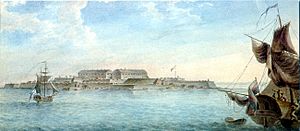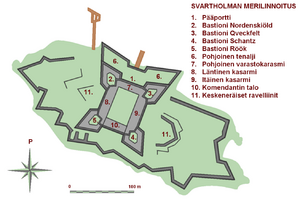Svartholm fortress facts for kids
The Svartholm fortress (which means "Black Islet fortress") was a strong fort built on an island near Loviisa in Southern Finland. It was constructed between 1749 and 1764 by a Swedish military engineer named Augustin Ehrensvärd. This sea fortress was placed at the entrance of the Bay of Loviisa. Its main job was to stop Russian forces from sailing into what was then Swedish territory in Finland. It worked together with a planned land fort in Loviisa to protect the area.
Contents
Building the Fortress
After Sweden lost some important wars, like the Great Northern War and the Russo-Swedish War of 1741-1743, they really needed to build new defenses. These forts would protect both their borders and the coast of Finland. By 1745, the town of Degerby (which later became Loviisa) was chosen as a good spot for a border fort. To protect it from enemy ships, a sea fortress at Svartholm was needed. Another big naval base for the Swedish navy was also planned for Sveaborg.
Starting Construction
Lieutenant-Colonel Augustin Ehrensvärd created the plans for these new forts. He also got the job of building them in 1747. Construction began in 1748. The work sped up in 1749 and 1750 because the political situation with other countries was getting worse. More than half of the Swedish army in Finland helped with the building. In 1750, over 6,000 men were working on the forts at Svartholm and Sveaborg.
Ehrensvärd put Captain O. R. Clansenstierna in charge of the work at Degerby and Svartholm. Later, Lieutenant-Colonel Fabian Casimir Wrede took over from 1751 to 1757. In 1751, they had about 2,000 workers. Even though the plans for the town's defenses had to be made smaller, it didn't stop the building of Svartholm.
In 1751, King Adolf Frederick visited the site. During his visit, Degerby was renamed Lovisa (now Loviisa) in honor of his wife, Louisa Ulrika. Just like at Sveaborg, Sweden's involvement in the Seven Years' War caused the construction work to almost stop.
Later Stages of Building
Work on the Svartholm fortress continued in the 1770s. After Ehrensvärd passed away, Jacob Magnus Sprengtporten led the construction from 1773 to 1774. However, after he had a disagreement with King Gustav III, the work slowed down again.
By 1775, construction on the forts around Loviisa stopped. Only two of the six planned bastions (strong parts of the fort) were finished. Work at Svartholm also slowed down a lot, and by 1778, only small repairs were done. In 1788, when a new war against Russia started, the main part of Svartholm fort was ready. However, some of its outer walls were not yet completed.
Svartholm in Swedish Service
Svartholm was built as a sea fortress, but it was not designed to be a large naval base. It could only offer its cannons to support naval forces. Orders to get the fort ready were given on May 22, 1788. Svartholm didn't see much fighting during the Russo-Swedish War of 1788–1790. However, it was an important meeting point and starting place for troops at different times during the war.
The Finnish War (1808–1809)
The fortress at Svartholm was still not fully ready in 1808 when the Finnish War began. Only two-thirds of its cannons and mortars were available. People had noticed as early as the 1760s that the fort couldn't hold enough guns to stop a big attack from the sea. They also knew that the southern part of the fort was not very strong.
Svartholm had 86 cannons and 8 mortars, with a garrison (group of soldiers) of 700 men. But the fort had been neglected. Most of the gun carriages (the stands for the cannons) were rotten, and some cannons didn't even have carriages. The small guns for soldiers were also in bad shape. The fort lacked enough food and ammunition.
The commander of Svartholm before the war was Captain Carl Gustaf von Schoultz. He had to manage a poorly trained garrison. Only about a third of the soldiers had working weapons. Their spirits were low, and discipline was bad. Things didn't get better when Major Carl Magnus Gripenberg took command on February 15. Gripenberg was not well-liked by his superiors or his soldiers.
Efforts were made to prepare the fort for war, but the war started before the work was finished. Ammunition was scarce, especially for the larger cannons. There was also a shortage of food. To make things worse, drinking water was limited because several wells were unusable.
The Siege of Svartholm
Loviisa was the first target for the Russians in the Finnish War (1808–1809). The main Russian army crossed the border on February 21, 1808. The Russians quickly surrounded Svartholm on February 22, 1808. They demanded that the Swedes surrender, but the Swedes refused.
On February 23, more Russian troops arrived to surround the fort. This brought the Russian strength to about 1,700 men. However, messengers could still reach the fort. It wasn't until February 28 that Russian patrols finally cut off all routes to the fort.
The Russians tried to get the fortress to surrender through talks on March 2 and March 8, but the Swedes again refused. When Russian artillery started firing at the fort, it quickly became clear that only 8 of the fort's cannons could shoot at the Russians. The narrow openings for the cannons made it impossible to use the rest.
The fort was already struggling from the siege. One-sixth of the soldiers were sick, and they lacked warm clothes and food. Their spirits dropped even lower, and the officers worried about a mutiny.
On March 11, Gripenberg suggested a six-week truce. The Russian Major General Muchanoff quickly said no but agreed to a three-day truce. After that, the fighting would start again. Gripenberg agreed to surrender on March 14, even before the short truce ended. On March 17, the Russian General commanding the armies in Finland, Friedrich Wilhelm von Buxhoeveden, accepted the surrender.
The Swedes handed over the fortress with all its weapons to the Russians. In return, the Russians agreed to simply let the mostly Finnish soldiers from Svartholm go home. The exact reasons for the surrender are not fully clear. It seems that the Swedish officers did not believe that Sweden or the fortress could hold out against the Russians in this war.
Svartholm in Russian Service
Svartholm fortress lost its military importance during the time it was controlled by Russia. It was used partly as a military base and partly as a prison for Finnish prisoners.
During the Crimean War, two British ships, HMS Arrogant and HMS Magicienne, arrived at the fortress on July 7, 1855. They were commanded by Captain Hastings Yelverton. As soon as the British ships appeared, the Russians left the fortress and took its weapons with them. Captain Yelverton then blew up everything that was left behind.
However, many parts of the fortress survived the war. Svartholm continued to be a good harbor and a popular spot for weekend trips.
The Finnish National Board of Antiquities started restoring the castle in the 1960s. The restoration work was finally completed in 1998, making the historic fortress a great place to visit today.
Images for kids










